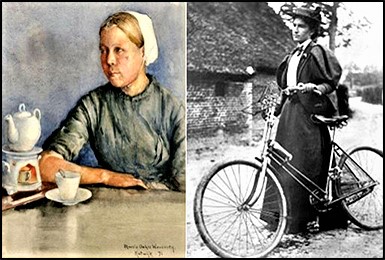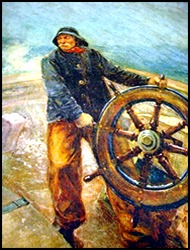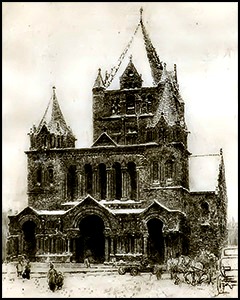

“[T]he schools had all got off to a good start and with all they gave me to do, I could no longer think of doing art… [Teaching] was something I enjoyed but constant thinking and indefatigable work no longer allowed me to sleep. Nervousness struck me and I even lost my appetite.”

As a passionately dedicated teacher, Tommaso Juglaris sometimes jeopardized his health in imparting everything he possibly could to his pupils. But his reward was a bevy of students who loved and cherished him. Above and beyond his sheer skill with figural drawing and his knowledge of the European art tradition, Juglaris was appreciated for his pragmatic approach to art and the good example of his own discipline at the easel. Among the ranks of Juglaris’s students were Henry Hammond Gallison, Edward Wilbur Dean Hamilton, Charles Harold Davis, "Susy" Marcia Oakes Woodbury, Augustus W. Buhler, Sears Gallagher, and Childe Hassam. Other lesser-known Juglaris students who nevertheless pursued successful careers as painters, illustrators, stained glass designers, and art educators include Mary Evangeline, Clara Goodyear, Frank Hendry, Edith Frances Foster, Flora MacDonald, and Annette Warner.

Henry Gallison ended up closely collaborating with Juglaris on the decoration for America’s oldest public library in Franklin, Massachusetts, where his landscape paintings still hang displayed. Meanwhile, Edward Wilbur Dean Hamilton, who studied and worked with Juglaris at the Rhode Island School of Design, gained attention as an artist of the “Boston School” with his varied portraits and landscapes. Attaining even greeter distinction was “Susy” Marcia Oakes Woodbury. Studying under Juglaris at the Boston Art Club every winter from 1885-86 through 1887-88, she became, as noted by art historian Annette Stott, “a nationally recognized watercolor painter and illustrator of American literature." Two of her paintings, Dutch Woman and Moeder en Dochter: Het Geheele Leven (Mother and Daughter: The Whole of Life), were respectively acquired by New York’s Metropolitan Museum of Art and Boston’s Museum of Fine Arts. Also taking instruction with Juglaris at the Boston Art Club, Augustus Buhler forged his own niche in the New England art world with highly iconic depictions of Cape Anne fishermen. One of his mariner paintings, Man at the Wheel, not only inspired the sculpted Gloucester Fishermen’s Memorial, They That Go Down to the Sea, but also the trademark logo for Gorton’s of Gloucester, a seafood company which owns the painting.

Perhaps even better remembered today is Sears Gallagher, a master etcher and watercolorist, who both studied and worked in Juglaris’s Boston studio. His etchings are represented in the collections of the Smithsonian American Art Museum, the Metropolitan Museum of Art, and the Boston Museum of Fine Arts. Recounting his own days as a student artist, Sears Gallagher credited Juglaris with providing “the severest training in drawing.”
Most famous of Juglaris’s students is Childe Hassam, who emerged as a leading Impressionist. In the words of art historians Warren Adelson, Jay Cantor, and William Gerdits, Hassam continues to be celebrated for “rain-swept city scenes, glorious seaside gardens, exquisite women, and stirring flag-lined streets." During the latter part of his career, Hassam’s forty-two known flag paintings in oil and watercolor captured America’s nationalist fervor as the First World War ended and a signed armistice, ushering in peace, saw the United States take a commanding role on the world stage. In an interview about the makings of his career, Childe Hassam fondly remembered Juglaris forty years after the fact as “an Italian painter who came over…a pleasant blonde Italian.” Reflecting back on those student days in 1884, Hassam recalled “always drawing from life under Juglaris” at the Boston Art Club, where he “worked steadily” in his class. Art historian Ulrich W. Heisinger has noted the importance of Juglaris’s Boston Art Club classes for Hassam. In his catalogue for an extensive 1994 exhibition of Hassam’s paintings at the Jordan-Volpe Gallery in New York City, Heisinger remarks: “The details of Hassam’s early studies are obscure, but we do know that he attended evening lectures and drawing classes at the Lowell Institute and, from 1883, also the life painting classes initiated that year by the Boston Art Club. One of the instructors was Tommaso Juglaris, a competent Italian painter who had come to Boston after studying in Paris under Jean-Leon Gerome and Alexandre Cabanel. Hassam applied himself in these life classes to highly realistic studies of the models, an effort that brought noticeable improvement to the extreme awkwardness of his earliest figure style.”

More recently, another art historian, Stephanie L. Herdrich, has also underscored just how seminal Hassam’s studies with Juglaris proved to be. In Childe Hassam: American Impressionist, published in conjunction with an exhibition organized by the Metropolitan Museum of Art, New York, Herdrich writes: “Juglaris’ impact on Hassam was significant. After his return to Boston, Hassam painted more often in oil, producing larger, more impressive and ambitious works, a development probably inspired by his exposure to great European art, but no doubt it also reflected an increased confidence in his use of the medium that Juglaris’s teaching would have instilled. Juglaris’s influence must have reinforced that of Hunt and the Barbizon aesthetic, which had already left its mark on Hassam.”
At a juncture when American art education was still a fledgling enterprise, Juglaris brought Old World knowledge to a New World setting and helped raise the bar for quality instruction. Further reflecting his commitment to education, Juglaris, along with fellow Rhode Island School of Design faculty member Warren Locke, translated for American publication Giacomo da Vignola’s famous sixteenth-century treatise, Rules of the Five Orders of Architecture, making classical architectural forms more familiar to students, anticipating a trend toward greater integration of architecture and art.